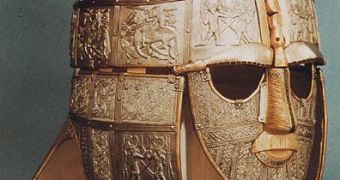There is no doubt that the English language rooted from a dialect brought in Britain from northern Germany. When Romans left Britain at the beginning of the 5th century, Britain fragmented in small Celt kingdoms and rival domains, which employed Germanic mercenaries in their inner fights, or against the Picts (a seemingly non Indo-European population from Scotland) and the Irish.
The legend says that a leader called Vortigen opened the way for the Germanic tribes, and that he did so by employing two Saxons, Hengist and Horsa. They subsequently turned against him. Saxons and other Germanic people could have been reached Britain between 425-450 AD. The mercenaries turned into invaders, bringing more of their kin, and the Britons retreated to the west. By 615 AD, Britons had retreated to the north and west, and later even Cornwall (West Wales) was conquered by Germanic tribes. Scotland, Wales and Ireland remained Briton and Celtic (the Celt border). The conquered territory was called Angleland, from the name of one Germanic tribe, Angles.
The invaders came from the northwest of Germany and belonged to various Germanic tribes: Saxons, Jutes, Angles and Frisians. They gave the name of English regions: Wessex ("West Saxon" [Land]), Essex ("East Saxon" [Land]), Sussex ("South Saxon" [Land]). Despite their different names, linguistic differences between invaders were minor, and they formed a single ethnic group: the Anglo-Saxons. Around the year 600, seven independent Anglo-Saxon kingdoms existed in Britain: Wessex, Essex, Kent, Sussex, East England, Mercia and Northumbria, and the Anglo-Saxons started to be Christianized.
The discovery of a Germanic marker in the Y-chromosome of British men made a team at the University College London point out that enslavement and apartheid imposed by Saxon invaders caused this: theoretically, Celt Briton males would have been impeded from having kids, as the Y chromosome is transmitted only from father to son. This had strengthened the idea that, AD 430 to 730, the Germanic conquerors established a master class, oppressing the native Britons, for whom inter-marriage was strictly forbidden. Meanwhile, the population of the invaders would have bloomed.
"But it is just not necessary to assume an apartheid-like system. The evidence is compatible with the idea of a much more integrated society," argues John Pattison of the University of South Australia in Adelaide, in a new research published in the Proceedings of the Royal Society B.
Pattison looked at existing archaeological and genetic proof, and made a new analysis of the British DNA. He considered the backwardness of the pre-Roman times and, for each generation, assessed the population growth and the root of immigrants.
"People with Germanic origins came to Britain well before and after the early Anglo-Saxon period, and this long period of immigration can explain a relatively strong Germanic genetic signal today. About 60% of the current British population still has some native Briton DNA, arguing against the idea that Saxon invaders ethnically purged the country. The textual and archaeological evidence collected (by previous studies) is also controversial," said Pattison.
Indeed, some Anglo-Saxon kings, like Ine of Wessex, did release codes that inflicted a heavier burden of taxes on native Britons than Saxons, but this was a method of assimilating Britons to the new Germanic culture and language, rather than being aimed directly at oppressing a lower class.
"Overall, the evidence suggests the picture of life in early Anglo-Saxon Britain was not as dismal as that portrayed by others. It was still the Dark Ages. People were pretty brutal and there was a lot of fighting going on - but it wasn't necessarily as grim for the Britons as has been suggested," Pattison explained.

 14 DAY TRIAL //
14 DAY TRIAL //